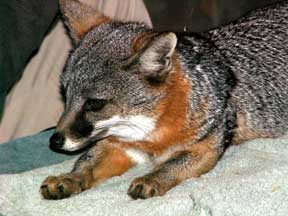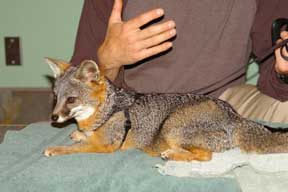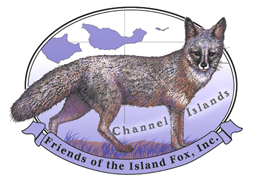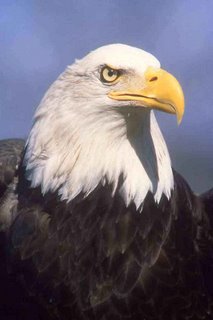Catalina Island Fox - Tachi
Report From the Field, 4/22/06 - by Pat Meyer
Friends of the Island Fox traveled to Santa Catalina Island to participate in the Catalina Island Conservancy’s Earth Day celebration and the opening of their new Nature Center at Avalon Canyon.
The highlight of the day was meeting Tachi, Catalina Island Conservancy’s educational ambassador. This young female island fox plays an important role in enlightening people about this endangered species. Though incredibly cute, she is not a pet. While I was allowed to be photographed with Tachi, I was not allowed to get too close to her, or to touch her at all. She is handled only by the Catalina Island Conservancy biologists.
Tachi’s story:
Her full name is Ne Shun Tachi – “Our little girl of hope.” She was born in a litter that was neglected by their mother. It was determined very early in her life that she had an eye infection. She continued to have chronic eye infections and difficulty nursing from her foster mother, so she was returned to the Institute of Wildlife Studies’ veterinary clinic periodically. While receiving treatment, her eye opened and she became habituated to the humans that cared for her. Consequently Tachi was not able to be released into the wild with her siblings and has become an educational ambassador for her species.
Friends of the Island Fox, Inc. sends our appreciation to the Catalina Island Conservancy’s Chief Conservation and Education Officer, Carlos de la Rosa, and Ann Muscat, Chief Executive Officer, for their invitation to participate in their Earth Day celebration.
Spring population numbers are showing increases on all of the islands. There will be more captive fox pups who will need radio collars for release into the wild. Our motto is “Working Together To Save The Island Fox.” You can make a difference. Join us and our friends at the Catalina Island Conservancy as we strive to save the island fox from extinction.

Friends of the Island Fox traveled to Santa Catalina Island to participate in the Catalina Island Conservancy’s Earth Day celebration and the opening of their new Nature Center at Avalon Canyon.
The highlight of the day was meeting Tachi, Catalina Island Conservancy’s educational ambassador. This young female island fox plays an important role in enlightening people about this endangered species. Though incredibly cute, she is not a pet. While I was allowed to be photographed with Tachi, I was not allowed to get too close to her, or to touch her at all. She is handled only by the Catalina Island Conservancy biologists.

Tachi’s story:
Her full name is Ne Shun Tachi – “Our little girl of hope.” She was born in a litter that was neglected by their mother. It was determined very early in her life that she had an eye infection. She continued to have chronic eye infections and difficulty nursing from her foster mother, so she was returned to the Institute of Wildlife Studies’ veterinary clinic periodically. While receiving treatment, her eye opened and she became habituated to the humans that cared for her. Consequently Tachi was not able to be released into the wild with her siblings and has become an educational ambassador for her species.

Friends of the Island Fox, Inc. sends our appreciation to the Catalina Island Conservancy’s Chief Conservation and Education Officer, Carlos de la Rosa, and Ann Muscat, Chief Executive Officer, for their invitation to participate in their Earth Day celebration.
Spring population numbers are showing increases on all of the islands. There will be more captive fox pups who will need radio collars for release into the wild. Our motto is “Working Together To Save The Island Fox.” You can make a difference. Join us and our friends at the Catalina Island Conservancy as we strive to save the island fox from extinction.



